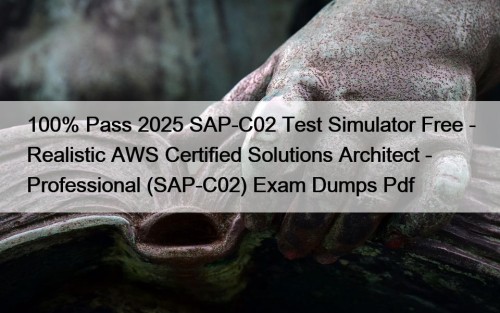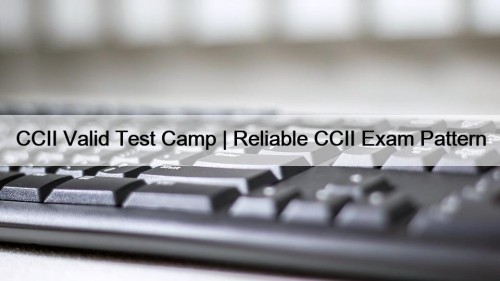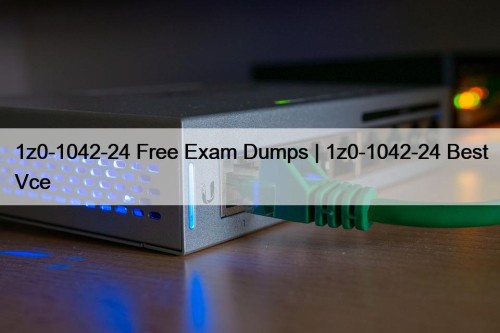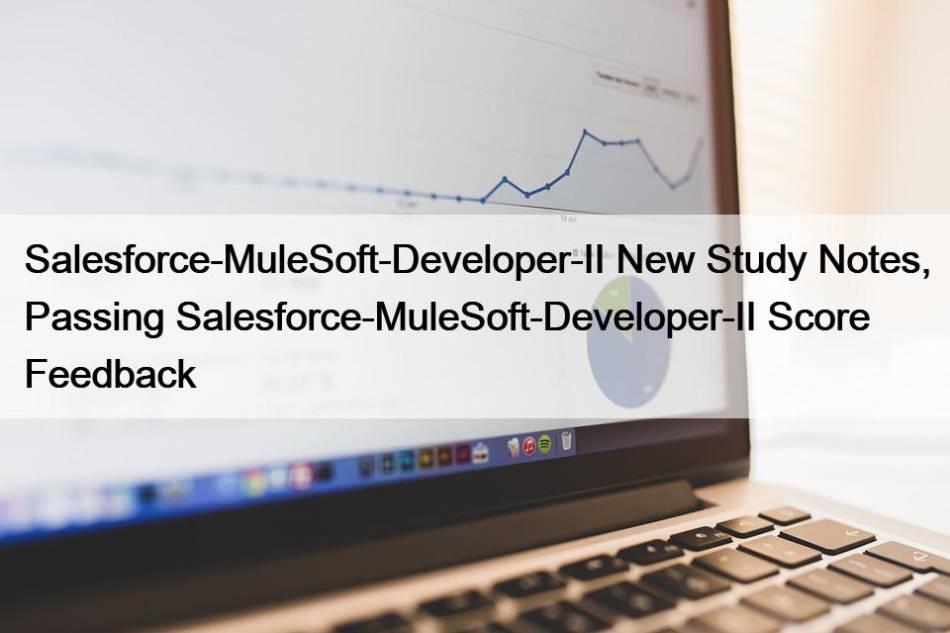Most Popular
 100% Pass 2025 SAP-C02 Test Simulator Free - Realistic AWS Certified Solutions Architect - Professional (SAP-C02) Exam Dumps Pdf
100% Pass 2025 SAP-C02 Test Simulator Free - Realistic AWS Certified Solutions Architect - Professional (SAP-C02) Exam Dumps Pdf
BONUS!!! Download part of Test4Cram SAP-C02 dumps for free: https://drive.google.com/open?id=1O5sOtC5lbaodd99M6vkGk1e4eqYRHQ7hOur ...
 CCII Valid Test Camp | Reliable CCII Exam Pattern
CCII Valid Test Camp | Reliable CCII Exam Pattern
When you decide to pass CCII exam, you must want ...
 1z0-1042-24 Free Exam Dumps | 1z0-1042-24 Best Vce
1z0-1042-24 Free Exam Dumps | 1z0-1042-24 Best Vce
BONUS!!! Download part of 2Pass4sure 1z0-1042-24 dumps for free: https://drive.google.com/open?id=1hM878IFVOFeykBSRtKDNSXJpKtziYAazIt ...



Salesforce-MuleSoft-Developer-II New Study Notes, Passing Salesforce-MuleSoft-Developer-II Score Feedback

2025 Latest ExamsReviews Salesforce-MuleSoft-Developer-II PDF Dumps and Salesforce-MuleSoft-Developer-II Exam Engine Free Share: https://drive.google.com/open?id=1N5hk0BzNr5UUHfEAXY50hNVwpyhp5uHj
Our Salesforce Salesforce-MuleSoft-Developer-II study guide is the most reliable and popular exam product in the marcket for we only sell the latest Salesforce-MuleSoft-Developer-II practice engine to our clients and you can have a free trial before your purchase. Our Salesforce Salesforce-MuleSoft-Developer-II training materials are full of the latest exam questions and answers to handle the exact exam you are going to face. With the help of our Salesforce-MuleSoft-Developer-II Learning Engine, you will find to pass the exam is just like having a piece of cake.
Salesforce Salesforce-MuleSoft-Developer-II Exam Syllabus Topics:
| Topic | Details |
|---|---|
| Topic 1 |
|
| Topic 2 |
|
| Topic 3 |
|
| Topic 4 |
|
| Topic 5 |
|
>> Salesforce-MuleSoft-Developer-II New Study Notes <<
Passing Salesforce-MuleSoft-Developer-II Score Feedback - Salesforce-MuleSoft-Developer-II Trustworthy Dumps
In order to save you a lot of installation troubles, we have carried out the online engine of the Salesforce-MuleSoft-Developer-II latest exam guide which does not need to download and install. This kind of learning method is convenient and suitable for quick pace of life. But you must have a browser on your device. Also, you must open the online engine of the study materials in a network environment for the first time. In addition, the Salesforce-MuleSoft-Developer-II Study Dumps don’t occupy the memory of your computer. When the online engine is running, it just needs to occupy little running memory. At the same time, all operation of the online engine of the Salesforce-MuleSoft-Developer-II training practice is very flexible as long as the network is stable.
Salesforce Certified MuleSoft Developer II Sample Questions (Q13-Q18):
NEW QUESTION # 13
An order processing system is composed of multiple Mule application responsible for warehouse, sales and shipping. Each application communication using Anypoint MQ. Each message must be correlated against the original order ID for observability and tracing.
How should a developer propagate the order ID as the correlation ID across each message?
- A. Use the underlying HTTP request of Anypoint MQ to set the 'X-CORRELATION_ID' header to the order ID
- B. Use the default correlation ID, Anypoint MQ will sutomatically propagate it.
- C. Wrap all Anypoint MQ Publish operations within a With CorrelationID scope from the Tracing module, setting the correlation ID to the order ID
- D. Set a custom Anypoint MQ user property to propagate the order ID and set the correlation ID in the receiving applications.
Answer: C
Explanation:
To propagate the order ID as the correlation ID across each message using Anypoint MQ, the developer should wrap all Anypoint MQ Publish operations within a With CorrelationID scope from the Tracing module, setting the correlation ID to the order ID. The With CorrelationID scope allows setting a custom correlation ID for any event that occurs within it. The Tracing module also enables distributed tracing across different Mule applications and services using Anypoint Monitoring. Reference: https://docs.mulesoft.com/tracing-module/1.0/tracing-module-reference#with-correlation-id-scope https://docs.mulesoft.com/tracing-module/1.0/tracing-module-concepts
NEW QUESTION # 14
Refer to the exhibit.
A Mute Object Store is configured with an entry TTL of one second and an expiration interval of 30 seconds.
What is the result of the flow if processing between os'store and os:retrieve takes 10 seconds?
- A. nullPayload
- B. OS:KEY_NOT_FOUND
- C. originalPayload
- D. testPayload
Answer: A
Explanation:
The result of the flow is nullPayload if processing between os:store and os:retrieve takes 10 seconds. This is because the entry TTL of the object store is one second, which means that any stored value expires after one second and is removed from the object store. The expiration interval of 30 seconds only determines how often the object store checks for expired values, but it does not affect the TTL. Therefore, when os:retrieve tries to get the value after 10 seconds, it returns nullPayload because the value has already expired and been removed. Reference: https://docs.mulesoft.com/object-store/osv2-faq#how-does-the-time-to-live-work
NEW QUESTION # 15
Multiple individual Mute application need to use the Mule Maven plugin to deploy to CloudHub.
The plugin configuration should .. reused where necessary and anything project, specific should be property-based.
Where should the Mule Maven details be configured?
- A. Pom, xml
- B. A parent pom.xml
- C. Settings, xml
- D. A Bill of Materials (BOM) parent pm
Answer: B
Explanation:
To reuse Mule Maven plugin configuration across multiple individual Mule applications, the developer should use a parent pom.xml file. A parent pom.xml file defines common configuration for one or more child projects that inherit from it. The developer can specify common properties and dependencies for all child projects in the parent pom.xml file, such as Mule Maven plugin configuration, and then reference them in each child project's pom.xml file using placeholders. Reference: https://docs.mulesoft.com/mule-runtime/4.3/mmp-concept#parent-pom https://maven.apache.org/guides/introduction/introduction-to-the-pom.html#Project_Inheritance
NEW QUESTION # 16
A system API that communicates to an underlying MySQL database is deploying to CloudHub. The DevOps team requires a readiness endpoint to monitor all system APIs.
Which strategy should be used to implement this endpoint?
- A. Use an existing resource endpoint of the API
- B. Create a dedicated endpoint that responds with the API status only
- C. Create a dedicated endpoint that responds with the API status and reachability of the underlying systems
- D. Create a dedicated endpoint that responds with the API status and health of the server
Answer: C
Explanation:
To implement a readiness endpoint to monitor all system APIs, the developer should create a dedicated endpoint that responds with the API status and reachability of the underlying systems. This way, the DevOps team can check if the system API is ready to receive requests and if it can communicate with its backend systems without errors. Reference: https://docs.mulesoft.com/mule-runtime/4.3/deployment-strategies#readiness-probes
NEW QUESTION # 17
Refer to the exhibit.
What required changes can be made to give a partial successful response in case the United Airlines API returns with a timeout?
- A. Add Flow Reference components inside a Try scope.
Set the payload to a default value'' insider the error handler using the ON Error Continue scope - B. Add a Scatter-Gather component inside a Try scope.
Set the payload to a default value 'Error'' inside the error handler using the On Error Continue scope. - C. Add Flow Reference components inside a Try scope
Set the payload to a default value '' inside the error handler using the On Error Propagate scope - D. Add a Scatter-gather component inside a Try scope.
Set the payload to a default value 'Error' inside the error handler using the On Error Propagate scope.
Answer: B
Explanation:
To give a partial successful response in case the United Airlines API returns with a timeout, the developer should add a Scatter-Gather component inside a Try scope, and set the payload to a default value 'Error' inside the error handler using the On Error Continue scope. A Scatter-Gather component allows sending multiple requests concurrently and aggregating the responses into an array. A Try scope allows handling errors that occur within it using an error handler. An On Error Continue scope allows continuing the flow execution after handling an error. Therefore, by using these components, the developer can send requests to both APIs in parallel, handle any timeout errors from United Airlines API, and return a partial response with a default value for that API. Reference: https://docs.mulesoft.com/mule-runtime/4.3/scatter-gather-concept https://docs.mulesoft.com/mule-runtime/4.3/try-scope-concept https://docs.mulesoft.com/mule-runtime/4.3/on-error-continue-concept
NEW QUESTION # 18
......
More and more people hope to enhance their professional competitiveness by obtaining Salesforce-MuleSoft-Developer-II certification. However, under the premise that the pass rate is strictly controlled, fierce competition makes it more and more difficult to pass the Salesforce-MuleSoft-Developer-II examination. Whether you are the first or the second or even more taking Salesforce-MuleSoft-Developer-II examination, our Salesforce-MuleSoft-Developer-II exam prep not only can help you to save much time and energy but also can help you pass the exam. In the other words, passing the exam once will no longer be a dream.
Passing Salesforce-MuleSoft-Developer-II Score Feedback: https://www.examsreviews.com/Salesforce-MuleSoft-Developer-II-pass4sure-exam-review.html
- Salesforce-MuleSoft-Developer-II Valid Exam Test 😥 Salesforce-MuleSoft-Developer-II Cost Effective Dumps ⚾ Salesforce-MuleSoft-Developer-II Valid Study Guide 🤱 Simply search for ☀ Salesforce-MuleSoft-Developer-II ️☀️ for free download on ▛ www.lead1pass.com ▟ ↔Reliable Salesforce-MuleSoft-Developer-II Test Price
- Reliable Salesforce-MuleSoft-Developer-II Test Experience 🔯 Salesforce-MuleSoft-Developer-II Valid Exam Test 😅 New Salesforce-MuleSoft-Developer-II Exam Camp 🥻 Easily obtain free download of ✔ Salesforce-MuleSoft-Developer-II ️✔️ by searching on ⮆ www.pdfvce.com ⮄ 🎑Salesforce-MuleSoft-Developer-II Cost Effective Dumps
- Salesforce-MuleSoft-Developer-II Cost Effective Dumps 🧸 Reliable Salesforce-MuleSoft-Developer-II Test Price ☔ Reliable Salesforce-MuleSoft-Developer-II Exam Registration 🚜 Open { www.getvalidtest.com } and search for ▛ Salesforce-MuleSoft-Developer-II ▟ to download exam materials for free 🖍Salesforce-MuleSoft-Developer-II Latest Test Preparation
- Salesforce-MuleSoft-Developer-II Free Dumps ⭐ Latest Salesforce-MuleSoft-Developer-II Test Materials 🗨 Salesforce-MuleSoft-Developer-II Latest Test Preparation 🌜 Download ⇛ Salesforce-MuleSoft-Developer-II ⇚ for free by simply searching on ⇛ www.pdfvce.com ⇚ 📭Test Salesforce-MuleSoft-Developer-II Result
- Salesforce-MuleSoft-Developer-II Free Dumps 🐱 Practice Salesforce-MuleSoft-Developer-II Questions 🐹 Salesforce-MuleSoft-Developer-II Customized Lab Simulation 💞 Simply search for ▷ Salesforce-MuleSoft-Developer-II ◁ for free download on ( www.exam4pdf.com ) 🪑Salesforce-MuleSoft-Developer-II Test Voucher
- Real Salesforce-MuleSoft-Developer-II Question 🍥 Practice Salesforce-MuleSoft-Developer-II Questions 🏍 Salesforce-MuleSoft-Developer-II Latest Test Preparation ⤵ 「 www.pdfvce.com 」 is best website to obtain ⇛ Salesforce-MuleSoft-Developer-II ⇚ for free download 🎯Salesforce-MuleSoft-Developer-II Customized Lab Simulation
- Salesforce-MuleSoft-Developer-II New Study Notes Exam Pass at Your First Attempt | Salesforce Passing Salesforce-MuleSoft-Developer-II Score Feedback 💂 Simply search for 《 Salesforce-MuleSoft-Developer-II 》 for free download on ▷ www.examsreviews.com ◁ 📍Salesforce-MuleSoft-Developer-II Cost Effective Dumps
- Salesforce Certified MuleSoft Developer II exam pdf guide - Salesforce-MuleSoft-Developer-II prep sure exam 🗾 Search for ⮆ Salesforce-MuleSoft-Developer-II ⮄ and download it for free on ➥ www.pdfvce.com 🡄 website 🚂Salesforce-MuleSoft-Developer-II Free Dumps
- New Salesforce-MuleSoft-Developer-II Exam Camp 📱 Reliable Salesforce-MuleSoft-Developer-II Test Questions 📐 New Salesforce-MuleSoft-Developer-II Exam Camp 📋 Copy URL 《 www.examcollectionpass.com 》 open and search for ▷ Salesforce-MuleSoft-Developer-II ◁ to download for free 🍃Salesforce-MuleSoft-Developer-II Free Dumps
- Latest Salesforce-MuleSoft-Developer-II Test Materials 🥺 Salesforce-MuleSoft-Developer-II Customized Lab Simulation 👶 Reliable Salesforce-MuleSoft-Developer-II Test Price 🚆 Easily obtain free download of 《 Salesforce-MuleSoft-Developer-II 》 by searching on ➽ www.pdfvce.com 🢪 📍Test Salesforce-MuleSoft-Developer-II Result
- Revolutionize Your Salesforce Exam Preparation with Our Web-Based Salesforce-MuleSoft-Developer-II Practice Test Software 🛃 Easily obtain ➤ Salesforce-MuleSoft-Developer-II ⮘ for free download through ☀ www.pdfdumps.com ️☀️ ✔Salesforce-MuleSoft-Developer-II Valid Exam Test
- Salesforce-MuleSoft-Developer-II Exam Questions
- kenkatasfoundation.org daliteresearch.com jaxlearningcentre.in alexisimport.com lifespaned.com pulasthibandara.com jackfox233.jts-blog.com el-kanemicollege.com korsely.com tanzeela.alnoordigitech.com
2025 Latest ExamsReviews Salesforce-MuleSoft-Developer-II PDF Dumps and Salesforce-MuleSoft-Developer-II Exam Engine Free Share: https://drive.google.com/open?id=1N5hk0BzNr5UUHfEAXY50hNVwpyhp5uHj
Tags: Salesforce-MuleSoft-Developer-II New Study Notes, Passing Salesforce-MuleSoft-Developer-II Score Feedback, Salesforce-MuleSoft-Developer-II Trustworthy Dumps, Trustworthy Salesforce-MuleSoft-Developer-II Exam Content, Practice Salesforce-MuleSoft-Developer-II Engine